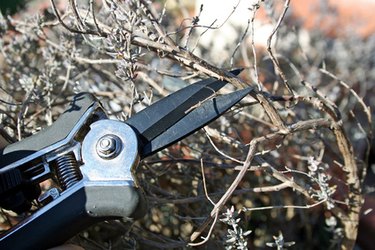
Many plants have sage in the common name, but the herb grown most often for culinary purposes is Salvia officinalis. This sage is a cold-hardy perennial that grows to about two feet tall. It has grayish-green leaves and a distinct sage smell. Sage, like many other herbs, grows better with occasional trimming or pruning. This pruning has a double benefit in making the plant stronger and more vigorous and providing fresh sage for cooking.
Step 1
Cut back sage plants in the spring. Cut the branches to just above a fork. Springtime is when you should shape sage plants, so prune them according to your idea of how you want them to look.
Video of the Day
Step 2
Prune sage plants again just before they bloom. Prune above a fork in the branch, or above a pair of leaves.
Step 3
Prune as desired throughout the summer for culinary purposes and to keep the plant from getting leggy.
Step 4
Let sage plants grow in the fall to let them store food for the winter. Stop pruning in late August or September.
Video of the Day